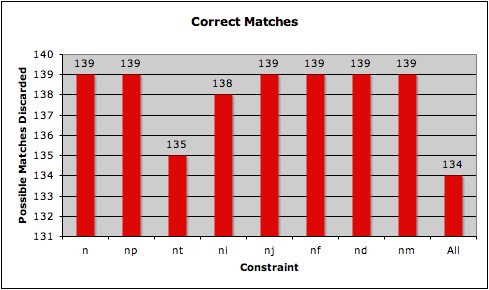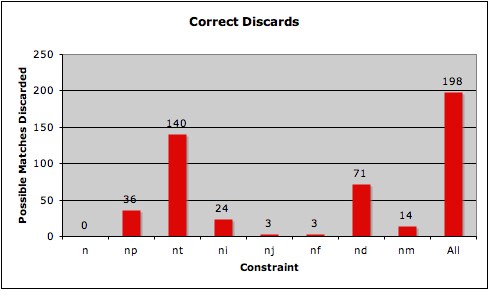The accuracy and usefulness of each constraint is determined by comparing
the manual mapping to the results of the automatic mapping algorithm for
those classes covered by the manual mapping. The manual mapping produced
the following results:
The automatic matching algorithm is the sum of its parts, i.e. the constraints it implements. A constraint is good if it does not incorrectly discard actual matches and if it discards as many of the actual discards as it can. No one constraint can discard all of the possible matches that need to be discarded. They work in unison. Below are two charts. The first describes the number of possible matches that the constraint matched correctly (i.e. the manual mapping had the same match). The second chart shows the number of possible matches that the constraint discarded correctly (i.e. the manual mapping discarded the same possible match).   As you can see only t and i incorrectly discarded a possible match. The counts for the 'Correct Discards' chart do not add up to the 'All' column because some of the constraints discard the same possible matches (there's overlap). The naive algorithm does not correctly discard any that the manual mapping discarded since the manual mapping began with naive matches. When shown as a percentage of the total possible in each category we have:
Now that we've seen the relative accuracy and usefulness of each constraint on the manual mapping data, what effect does each have on the whole of the possible VerbNet-Cyc mapping? If there are 29,245 verb-frame pairs in VerbNet, and 3,256 Cyc rules, then there are 29,245 x 3,256 = 95,221,720possible matches. But this huge number includes extraneous possible matches (like between a verb-frame pair for verb 'jump' and the Cyc rule for verb 'smash'). After the naive constraint is applied we get 26,162 possible matches. From this number we can see the effect each constraint has on all the data. Below is number of possible matches discarded for all naive matches:
You'll notice that a constraint's performance in the manual mapping does not necessarily directly correspond to the effect it will have on the complete of data. The Adjective constraint, for example, has 9 times less of an effect on the manual mapping than the Infinitive/Gerund rule (by discards), yet on the whole it affects more of the entire data (in terms of discards). This is because the manual mapping can emphasize different types of rules just based on the arbitrary manner by which the classes are represented. Finally, a rough check can be made as to how reasonable these numbers sound. The manual mapping analyzed 403 possible matches and found 139 of them to be valid. This is a 139 / 403 = 34.5% conversion ratio. The final automatic mapping matched 10,043 matches (26,162 - 16,119 = 10,043). Thus the conversion ratio is 10,043 / 26,162 = 38%. With some more constraints it is reasonable to assume the automatic mapping could approach the actual conversion ratio discovered by the manual mapping. The final mapping is provided here. It is in XML format and references Cyc rule numbers as specified in the adjoining files. A compressed version is also provided. The Cyc rule numbers in the final mapping file correspond to how they are numbered in the above rule files (the numbering corresponds to order in which they exist in the file). |
||||||||||||||||||||||||||||||||||||||||||||||||||||||||||||||||||||||||
| This page created on 2006.10.25. | Cyc rules are copyright © 1995 - 2006 Cycorp |